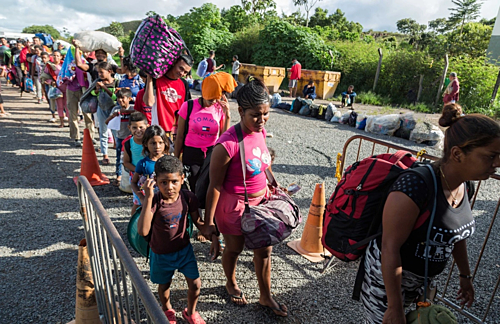
Since the beginning of the Venezuelan migration crisis, several countries in the international community, among the richest in the world, have already invested more than 2.5 billion dollars in assistance programs. However, more than half of Venezuelans who left their country still face basic needs and are in a vulnerable situation.
The data comes from the R4V Regional Interagency Coordination Platform, a forum created in 2018 in partnership with the United Nations (UN) to coordinate the actions of the agency’s agencies to assist Venezuelan migrants. The funds are raised by R4V to implement the Venezuelan Refugee and Migrant Response Plan (RMRP) in 17 countries in Latin America.
According to a report published last Monday (11), more than 4.4 million migrants from Venezuela are in conditions of need, a concept that measures the degree of lack of access to services and rights such as education, food security, housing and health.
:: What’s happening in Venezuela ::
The number of migrants in these conditions represents almost 68% of the total number of Venezuelans who have already left their country. According to figures from R4V itself, there are more than 7.7 million. Data on total migrants were compiled according to figures provided by the governments of receiving countries and therefore each decimal may not represent a single individual.
Four years after the first massive waves of migrants and aid plans were implemented, the accumulated amount in donations and transfers from entities in different countries around the world through R4V between 2019 and August 2023 was 2.504 billion dollars. However, despite the billion-dollar investment, the situation of millions of Venezuelans is vulnerable.
Of the more than 4 million in need, 54% lack access to healthcare, 48% to housing and more than 60% to integration with local populations. Furthermore, in most receiving countries, lack of integration, protection and food security were listed by migrants as the three main problems faced.
::USA changes rules and limits entry of Venezuelans; motivation is political, experts point out::
For Ana Gabriela Salazar, researcher at the Venezuelan human rights NGO Sures, the political context implicit in the Venezuelan migration issue has stimulated a process of “commodification” of migration and placed obstacles to binational dialogue between receiving countries and Venezuela, which she points out as fundamental mechanism for resolving the crisis.
“After the first years of encouraging the migration of Venezuelans, with some facilities offered, today the reality is that many countries require visas and bureaucratic procedures that restrict the entry and stay of these people”, he states. According to the R4V report, more than 36% of migrants are in an irregular situation in receiving countries. For Salazar, these spaces for dialogue between Latin American governments and Venezuela were obstructed by the so-called “maximum pressure” policy drawn up by the USA, which several countries in the region adhered to.
“This strategy included the application of sanctions against Venezuela during the Donald Trump administration and this increased Venezuelan migration, as people sought to improve their living conditions due to the effects of the economic situation in the country. This coincided with the decision of some Latin -Americans of ignoring the Venezuelan government, breaking relations, closing embassies and this hindered possible binational solutions to the migration problem”, he points out.
The researcher says that it is impossible to dissociate the rise in political tensions between Venezuela and the USA from the migration crisis. In 2014, the South American country was declared by Washington as an “unusual and extraordinary threat”, which allowed the application of economic sanctions that worsened from 2019, when the oil industry, the most dynamic hub of the Venezuelan economy, was blocked.
::Driven by oil, trade between Venezuela and the USA grows 555% in the 1st half of the year::
Since then, Venezuela has been the target of more than 900 sanctions which, according to official figures, have caused a 98% loss in dollar revenue and a contraction of more than 75% in GDP. According to R4V data, the majority of donations to the Venezuelan migration assistance fund come from the USA and the European Union, which are precisely the formulators and enforcers of sanctions against Venezuela.
In 2018, the Venezuelan government created a repatriation plan for migrants who express a desire to return to the country. However, the program faces difficulties such as the lack of diplomatic representation in some nations and political friction between governments. The last significant case of complications during repatriation occurred with 115 migrants who were stranded on the Chile-Peru border.
Little money?
Despite the 2.5 billion dollars that have been raised since 2019, the UN High Commissioner for Refugees has warned of the need for more funding. Last Tuesday (12), one day after the publication of the R4V report, the UNHCR said that “increasing funding for countries in the region [América Latina] It’s extremely necessary.”
This is because the agency claims that of the 1.7 billion stipulated by R4V as the necessary budget for the year 2023, only 12% of the total had been collected by August. “New investments can save lives,” says the UN.
For Venezuelan sociologist Luis Ernesto Navas, a researcher on migration issues in the region, the United Nations’ warning is neither extraordinary nor unprecedented. “I have already listened to two international conferences in previous R4V years and this type of request for more investment is normal,” he says.
::In the USA, Petro meets with Biden and calls for an end to sanctions against Venezuela::
The researcher also says he does not believe that rich countries such as Europe and the USA have “abandoned” the migration issue, nor that the receiving countries have stopped dealing with the issue. “What there is is a change in the rhetoric of some countries, but I don’t think there is a change in relation to financing, because it has always been like this, you never receive the full amount stipulated and offered”, he says.
In fact, the fundraising targets for donations planned by R4V have never been fully achieved since the beginning of the project. In 2019, the platform managed to raise 52% of the total, which represented 384 million dollars. In 2020, 46% of the stipulated amount was collected, in 2021 it was 40% and in 2022 just over 37%.
Despite having the lowest percentage, last year was the period in which the platform managed to raise the most donations and transfers, totaling more than 667 million dollars. This year’s measurement only corresponds to the month of August and totals 205 million dollars.
Editing: Patrícia de Matos
Source: www.brasildefato.com.br

